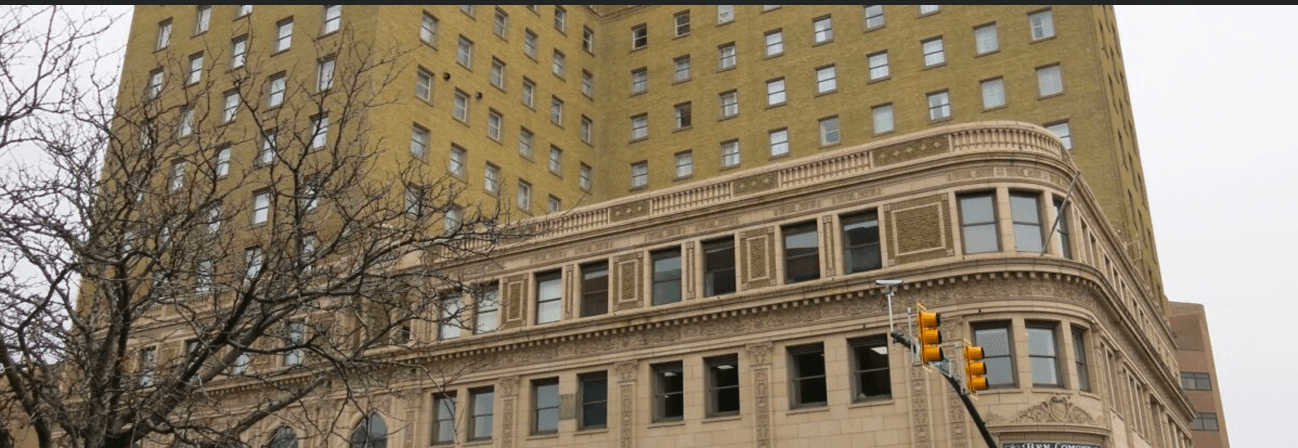Like many wild west states, Utah has its fair share of rough and tumble stories, but there were small reprieves from the lawlessness outside with grand hotels, usually built for traveling dignitaries and other important people to have a safe haven. It’s also not surprising that most of these grand hotels are haunted. We’ve covered a few of those wild locations with ghostly apparitions still enjoying the hotel’s hospitality. Today we explore what seems like the “Real 1408,” a reference to the story by Stephen King of the same name. The sheer amount of death that has happened at the Bigelow Hotel makes its haunting reputation credible.
Originally, the location in Ogden, Utah where the hotel sits was a different hotel “The Reed,” built in 1891. Over the years, the hotel was demolished and rebuilt to be fireproof in 1927. It went through still more name changes as the years went on. The new hotel now housed 350 suites with 11 dining rooms, two ballrooms and a coffee shop on the ground floor.

After the Reed, it was known as the Ben Lomand hotel before being renamed a final time as the original Bigelow Hotel. In the 1980s, the hotel was refurbished again to become a condo hotel, with permanent and temporary residents. Some of the more permanent residents today, however, are the kind that go bump in the night.
Many of the deaths reported in this haunted hotel are due to natural causes or old age, however there’s the occasional story that pulls the tragedy of the hotel together. Suicides, murders, and accidents also took lives from the residents and guests and left their mark on the imposing brick building.

When the building was still known as the Reed Hotel, a couple, the Van Alens, moved into a room on the 3rd floor in 1901. Suffering from many mental illnesses, Mrs. Van Alen shot herself in the head while her husband was off at work. He came home to find her in that state, and legend says she is still on the 3rd floor, looking after those who would live or rest in her former apartments.
In 1921, another tragedy befell the hotel when an employee, a cook in the restaurant, would accidentally fall to his death in the elevator shaft. They believe the doors opened without the elevator in position and the cook stepped without looking- falling 3 stories to the bottom.

Next, a murder occurred in 1929, in the newly rebuilt Bigelow Hotel when a part seemed to get out of control. The ballroom was alive with music and dancing as several friends convened in a room on the 12th floor. A woman had had a bit too much to drink and passed out on a couch. A man named Edward Spelman left the room with the others, and then came back to assault the inebriated woman. He was caught in the act by Dan Rowlands, who dodged Spelman’s attack as he tried to hit the man. His own punch would be a fatal one for the would be rapist, hitting him squarely in the head, knocking him down, where his head hit the wall and he was killed pretty much instantly.
More tragedy struck, which is becoming a theme with this hotel, you can see. This time, in the 1930s, two young men had an argument on the ground floor, went to the elevator to ask to be taken to the top floor, where they promptly jumped to their deaths. The last recorded suicide in the hotel occurred in 1951, when a school teacher followed suit of the two men and jumped to her own death from the 8th floor.

The most horrific and infamous murder took place within the walls of the hotel in 1976, when the body of a man named Henry Topping, Jr was discovered just after 2 am on the floor of the lobby. Henry had been working as a hotel clerk before he was stabbed 44 times and left to die on the lobby floor. Police would later arrest and charge a 15-year-old boy for the ordeal.
Another tale of a woman who killed herself on the 11th floor has an even more tragic ending. She was said to have drowned herself in the bathtub on her honeymoon. Days later, the adult son of the woman came to collect her things and would end up killing himself as well in grief for his mother.
With a hotel with as bloody history as the Bigelow, It’s not surprising that the building is reportedly very, very haunted. Souls of those who died on the grounds continue to show themselves in the long hallways of the vintage hotel. It’s reported that the elevator in the new building still carries the memory of the cook who fell to his death in the Reed hotel. Elevator doors are said to open by themselves, or be called to floors without any guests or residents.

The Bigelow Hotel is like a compilation of all the greatest haunting hits. Cold spots throughout the hotel, ghostly apparitions of those long passed, and more specific corporeal mischief, with bathtub taps turning on themselves, windows being left open when staff specifically remember closing them. Ghostly music is said to be heard throughout the ballrooms, echoing parties from years past. Voices are said to whisper in the halls of the 11th floor, considered the most haunted part of the hotel, and residents have even felt unseen hands pushing them. One would feel this ghostly hand and turn around to a long and empty hallway behind them.
Today, the Bigelow Hotel embraces its bloody past and is a staple on Ogden Ghost Tours. Next time you’re in Utah, give this spooky hotel a shot, and see if you can meet some of the former residents. They might not have much to say, but they’ll make sure you’re aware of their presence. Just make sure to ask for a room on the 11th floor.
A special thanks to Dead History for their extensive research that made this article possible. Be sure to check out their site if you love haunted history. (Which you should, since you’re reading Ghostlandia.)
- About the Author
- Latest Posts

Born in Death Valley and raised on the prairie, Deborah is a Wyoming-based paranormal researcher and University of Wyoming graduate. Her interests lie in folklore, history, symbolic interaction and research. She also researches the paranormal academically and is a graduate student studying sociology.


